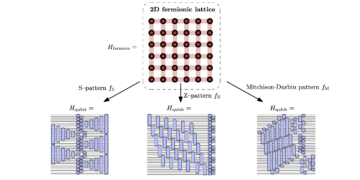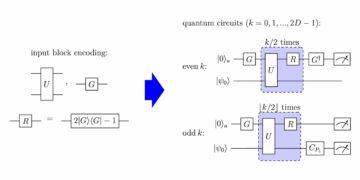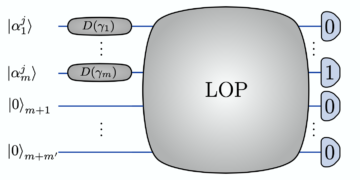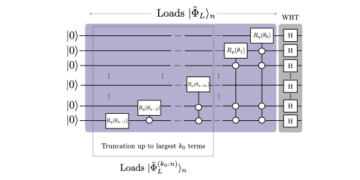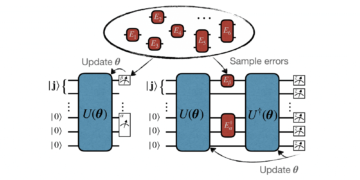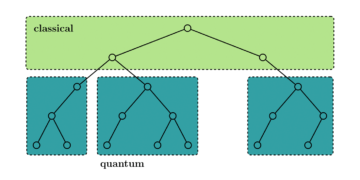
1Institute for Quantum Information, RWTH Aachen University, Aachen, Germany
2Department of Computing, Imperial College London, London, UK
3Institute for Quantum Information and Matter, California Institute of Technology, Pasadena, CA, USA
4AWS Center for Quantum Computing, Pasadena, CA, USA
5Department of Mathematics and Statistics, Institute for Quantum Science and Technology, University of Calgary, AB, Canada T2N 1N4
6Institut für Theoretische Physik und IQST, Universität Ulm, Albert-Einstein-Allee 11, D-89069 Ulm, Germany
7QuSoft, Science Park 123, 1098 XG Amsterdam, The Netherlands
8Korteweg–de Vries Institute for Mathematics, University of Amsterdam, Science Park 105-107, 1098 XG Amsterdam, The Netherlands
9Institute for Theoretical Physics, University of Amsterdam, Science Park 904, 1098 XH Amsterdam, The Netherlands
10Mathematical Quantum Information RIKEN Hakubi Research Team, RIKEN Cluster for Pioneering Research (CPR) and RIKEN Center for Quantum Computing (RQC), Wako, Saitama 351-0198, Japan
11Department of Physics, Graduate School of Science, The University of Tokyo, Bunkyo-ku, Tokyo 113-0033, Japan
12Center for Quantum Technologies, National University of Singapore, Singapore
13Department of Electrical and Computer Engineering, College of Design and Engineering, National University of Singapore, Singapore
Find this paper interesting or want to discuss? Scite or leave a comment on SciRate.
Abstract
We show that the proof of the generalised quantum Stein’s lemma [Brandão & Plenio, Commun. Math. Phys. 295, 791 (2010)] is not correct due to a gap in the argument leading to Lemma III.9. Hence, the main achievability result of Brandão & Plenio is not known to hold. This puts into question a number of established results in the literature, in particular the reversibility of quantum entanglement [Brandão & Plenio, Commun. Math. Phys. 295, 829 (2010); Nat. Phys. 4, 873 (2008)] and of general quantum resources [Brandão & Gour, Phys. Rev. Lett. 115, 070503 (2015)] under asymptotically resource non-generating operations. We discuss potential ways to recover variants of the newly unsettled results using other approaches.
[embedded content]
Popular summary
The applications of this result were manifold, but perhaps the most important was the identification of a framework for quantum resource manipulation that would become completely reversible. In this framework, discovered by Brandão and Plenio in 2008 and later generalised to almost all quantum resources by Brandão and Gour, the given resource could be freely converted from one form into the other at no (theoretical) loss. This mimics the classical thermodynamical behaviour of work and heat, which can be reversibly transformed into each other by Carnot cycles. For the case of entanglement theory, even more connections were established: notably, in this framework the distillable entanglement of any state is precisely equal to its Stein exponent.
In our work, we however report the existence of a serious gap in the original proof of the generalised quantum Stein’s lemma. Consequently, it remains uncertain whether this result is ultimately valid or not — the proof is incomplete, but we do not know of any counterexample to the original claim either. The results by Brandão and Plenio on reversibility of entanglement, and the subsequent ones on reversibility of general quantum resources, are now to be considered unproven. We discuss this state of affairs in detail, listing the affected results and explaining how to recover some of them. We also examine various ways of proving alternative but weaker forms of the generalised quantum Stein’s lemma. One of the goals of this paper is to stimulate further research on this problem, which appears to be one of the major open problems in the field of quantum entanglement theory and quantum resource theories in general, and whose complete solution would represent major progress in our understanding of the mysterious quantum world.
► BibTeX data
► References
[1] A. Anshu, M. Berta, R. Jain, and M. Tomamichel. A minimax approach to one-shot entropy inequalities. J. Math. Phys., 60:122201, 2019. doi:https://doi.org/10.1063/1.5126723.
https://doi.org/10.1063/1.5126723
[2] K. M. R. Audenaert, M. Nussbaum, A. Szkoła, and F. Verstraete. Asymptotic error rates in quantum hypothesis testing. Commun. Math. Phys., 279(1):251–283, 2008. doi:https://doi.org/10.1007/s00220-008-0417-5.
https://doi.org/10.1007/s00220-008-0417-5
[3] F. G. S. L. Brandão, M. Horodecki, J. Oppenheim, J. M. Renes, and R. W. Spekkens. Resource theory of quantum states out of thermal equilibrium. Phys. Rev. Lett., 111:250404, 2013. doi:https://doi.org/10.1103/PhysRevLett.111.250404.
https://doi.org/10.1103/PhysRevLett.111.250404
[4] M. Berta, F. G. S. L. Brandão, and C. Hirche. On composite quantum hypothesis testing. Commun. Math. Phys., 385:55–77, 2021. doi:https://doi.org/10.1007/s00220-021-04133-8.
https://doi.org/10.1007/s00220-021-04133-8
[5] C. H. Bennett, G. Brassard, S. Popescu, B. Schumacher, J. A. Smolin, and W. K. Wootters. Purification of noisy entanglement and faithful teleportation via noisy channels. Phys. Rev. Lett., 76:722–725, 1996. doi:https://doi.org/10.1103/PhysRevLett.76.722.
https://doi.org/10.1103/PhysRevLett.76.722
[6] C. H. Bennett, H. J. Bernstein, S. Popescu, and B. Schumacher. Concentrating partial entanglement by local operations. Phys. Rev. A, 53:2046–2052, 1996. doi:https://doi.org/10.1103/PhysRevA.53.2046.
https://doi.org/10.1103/PhysRevA.53.2046
[7] T. Baumgratz, M. Cramer, and M. B. Plenio. Quantifying coherence. Phys. Rev. Lett., 113:140401, 2014. doi:https://doi.org/10.1103/PhysRevLett.113.140401.
https://doi.org/10.1103/PhysRevLett.113.140401
[8] M. Berta, M. Christandl, and R. Renner. The quantum reverse Shannon theorem based on one-shot information theory. Commun. Math. Phys., 306(3):579, 2011. doi:https://doi.org/10.1007/s00220-011-1309-7.
https://doi.org/10.1007/s00220-011-1309-7
[9] F. G. S. L. Brandão, M. Christandl, and J. Yard. Faithful squashed entanglement. Commun. Math. Phys., 306(3):805, 2011. doi:https://doi.org/10.1007/s00220-011-1302-1.
https://doi.org/10.1007/s00220-011-1302-1
[10] F. G. S. L. Brandão, M. Christandl, and J. Yard, 2023. Personal communications.
[11] F. Buscemi and N. Datta. The quantum capacity of channels with arbitrarily correlated noise. IEEE Trans. Inf. Theory, 56:1447–1460, 2010. doi:https://doi.org/10.1109/TIT.2009.2039166.
https://doi.org/10.1109/TIT.2009.2039166
[12] F. G. S. L. Brandão and N. Datta. One-shot rates for entanglement manipulation under non-entangling maps. IEEE Trans. Inf. Theory, 57:1754–1760, 2011. doi:https://doi.org/10.1109/TIT.2011.2104531.
https://doi.org/10.1109/TIT.2011.2104531
[13] C. H. Bennett, I. Devetak, A. W. Harrow, P. W. Shor, and A. Winter. The quantum reverse Shannon theorem and resource tradeoffs for simulating quantum channels. IEEE Trans. Inf. Theory, 60(5):2926–2959, 2014. doi:https://doi.org/10.1109/TIT.2014.2309968.
https://doi.org/10.1109/TIT.2014.2309968
[14] C. H. Bennett, D. P. DiVincenzo, J. A. Smolin, and W. K. Wootters. Mixed-state entanglement and quantum error correction. Phys. Rev. A, 54:3824–3851, 1996. doi:https://doi.org/10.1103/PhysRevA.54.3824.
https://doi.org/10.1103/PhysRevA.54.3824
[15] M. Berta, O. Fawzi, and M. Tomamichel. On variational expressions for quantum relative entropies. Lett. Math. Phys., 107(12):2239–2265, 2017. doi:https://doi.org/10.1007/s11005-017-0990-7.
https://doi.org/10.1007/s11005-017-0990-7
[16] F. G. S. L. Brandão and G. Gour. Reversible framework for quantum resource theories. Phys. Rev. Lett., 115:070503, 2015. doi:https://doi.org/10.1103/PhysRevLett.115.070503.
https://doi.org/10.1103/PhysRevLett.115.070503
[17] F. G. S. L. Brandão, A. W. Harrow, J. R. Lee, and Y. Peres. Adversarial hypothesis testing and a quantum Stein’s lemma for restricted measurements. IEEE Trans. Inf. Theory, 66:5037–5054, 2020. doi:https://doi.org/10.1109/TIT.2020.2979704.
https://doi.org/10.1109/TIT.2020.2979704
[18] M. Berta and C. Majenz. Disentanglement cost of quantum states. Phys. Rev. Lett., 121:190503, 2018. doi:https://doi.org/10.1103/PhysRevLett.121.190503.
https://doi.org/10.1103/PhysRevLett.121.190503
[19] F. G. S. L. Brandão and M. B. Plenio. Entanglement theory and the second law of thermodynamics. Nat. Phys., 4:873, 2008. doi:https://doi.org/10.1038/nphys1100.
https://doi.org/10.1038/nphys1100
[20] F. G. S. L. Brandão and M. B. Plenio. A generalization of quantum Stein’s lemma. Commun. Math. Phys., 295(3):791–828, 2010. doi:https://doi.org/10.1007/s00220-010-1005-z.
https://doi.org/10.1007/s00220-010-1005-z
[21] F. G. S. L. Brandão and M. B. Plenio. A reversible theory of entanglement and its relation to the second law. Commun. Math. Phys., 295(3):829–851, 2010. doi:https://doi.org/10.1007/s00220-010-1003-1.
https://doi.org/10.1007/s00220-010-1003-1
[22] S. Beigi and P. W. Shor. Approximating the set of separable states using the positive partial transpose test. J. Math. Phys., 51:042202, 2010. doi:https://doi.org/10.1063/1.3364793.
https://doi.org/10.1063/1.3364793
[23] C. H. Bennett, P. W. Shor, J. A. Smolin, and A. V. Thapliyal. Entanglement-assisted capacity of a quantum channel and the reverse Shannon theorem. IEEE Trans. Inf. Theory, 48(10):2637–2655, 2002. doi:https://doi.org/10.1109/TIT.2002.802612.
https://doi.org/10.1109/TIT.2002.802612
[24] M. Berta and M. Tomamichel. Entanglement monogamy via multivariate trace inequalities. Preprint arXiv:2304.14878, 2023. doi:https://doi.org/10.48550/arXiv.2304.14878.
https://doi.org/10.48550/arXiv.2304.14878
arXiv:2304.14878
[25] E. Chitambar and G. Gour. Quantum resource theories. Rev. Mod. Phys., 91:025001, 2019. doi:https://doi.org/10.1103/RevModPhys.91.025001.
https://doi.org/10.1103/RevModPhys.91.025001
[26] E. Chitambar. Dephasing-covariant operations enable asymptotic reversibility of quantum resources. Phys. Rev. A, 97:050301, 2018. doi:https://doi.org/10.1103/PhysRevA.97.050301.
https://doi.org/10.1103/PhysRevA.97.050301
[27] T. Cooney, M. Mosonyi, and M. M. Wilde. Strong converse exponents for a quantum channel discrimination problem and quantum-feedback-assisted communication. Commun. Math. Phys., 344(3):797–829, 2016. doi:https://doi.org/10.1007/s00220-016-2645-4.
https://doi.org/10.1007/s00220-016-2645-4
[28] M. Christandl and A. Winter. Squashed entanglement: An additive entanglement measure. J. Math. Phys., 45(3):829–840, 2004. doi:https://doi.org/10.1063/1.1643788.
https://doi.org/10.1063/1.1643788
[29] N. Datta. Max-relative entropy of entanglement, alias log robustness. Int. J. Quantum Inform., 07:475–491, 2009. doi:https://doi.org/10.1142/S0219749909005298.
https://doi.org/10.1142/S0219749909005298
[30] N. Datta. Min- and Max-Relative Entropies and a New Entanglement Monotone. IEEE Trans. Inf. Theory, 55:2816–2826, 2009. doi:https://doi.org/10.1109/TIT.2009.2018325.
https://doi.org/10.1109/TIT.2009.2018325
[31] M. J. Donald. On the relative entropy. Commun. Math. Phys., 105(1):13–34, 1986. doi:https://doi.org/10.1007/BF01212339.
https://doi.org/10.1007/BF01212339
[32] I. Devetak and A. Winter. Distillation of secret key and entanglement from quantum states. Proc. Royal Soc. A, 461(2053):207–235, 2005. doi:https://doi.org/10.1098/rspa.2004.1372.
https://doi.org/10.1098/rspa.2004.1372
[33] I. Devetak and J. Yard. Exact Cost of Redistributing Multipartite Quantum States. Phys. Rev. Lett., 100:230501, 2008. doi:https://doi.org/10.1103/PhysRevLett.100.230501.
https://doi.org/10.1103/PhysRevLett.100.230501
[34] P. Faist, M. Berta, and F. Brandão. Thermodynamic capacity of quantum processes. Phys. Rev. Lett., 122:200601, 2019. doi:https://doi.org/10.1103/PhysRevLett.122.200601.
https://doi.org/10.1103/PhysRevLett.122.200601
[35] M. Fekete. Über die Verteilung der Wurzeln bei gewissen algebraischen Gleichungen mit ganzzahligen Koeffizienten. Math. Z., 17(1):228–249, 1923. doi:https://doi.org/10.1007/BF01504345.
https://doi.org/10.1007/BF01504345
[36] K. Fang, O. Fawzi, R. Renner, and D. Sutter. Chain rule for the quantum relative entropy. Phys. Rev. Lett., 124:100501, 2020. doi:https://doi.org/10.1103/PhysRevLett.124.100501.
https://doi.org/10.1103/PhysRevLett.124.100501
[37] K. Fang, G. Gour, and X. Wang. Towards the ultimate limits of quantum channel discrimination. Preprint arXiv:2110.14842v1, 2021. doi:https://doi.org/10.48550/arXiv.2110.14842.
https://doi.org/10.48550/arXiv.2110.14842
arXiv:2110.14842v1
[38] G. Ferrari, L. Lami, T. Theurer, and M. B. Plenio. Asymptotic state transformations of continuous variable resources. Commun. Math. Phys., 398(1):291–351, 2023. doi:https://doi.org/10.1007/s00220-022-04523-6.
https://doi.org/10.1007/s00220-022-04523-6
[39] C. A. Fuchs and J. van de Graaf. Cryptographic distinguishability measures for quantum-mechanical states. IEEE Trans. Inf. Theory, 45(4):1216–1227, 1999. doi:https://doi.org/10.1109/18.761271.
https://doi.org/10.1109/18.761271
[40] G. Gour, I. Marvian, and R. W. Spekkens. Measuring the quality of a quantum reference frame: The relative entropy of frameness. Phys. Rev. A, 80:012307, 2009. doi:https://doi.org/10.1103/PhysRevA.80.012307.
https://doi.org/10.1103/PhysRevA.80.012307
[41] G. Gour and A. Winter. How to quantify a dynamical quantum resource. Phys. Rev. Lett., 123:150401, 2019. doi:https://doi.org/10.1103/PhysRevLett.123.150401.
https://doi.org/10.1103/PhysRevLett.123.150401
[42] M. Hayashi. Optimal sequence of quantum measurements in the sense of Stein’s lemma in quantum hypothesis testing. J. Phys. A, 35(50):10759–10773, 2002. doi:https://doi.org/10.1088/0305-4470/35/50/307.
https://doi.org/10.1088/0305-4470/35/50/307
[43] C. W. Helstrom. Quantum detection and estimation theory. Academic press, 1976.
[44] M. Horodecki, P. Horodecki, and R. Horodecki. Mixed-state entanglement and distillation: Is there a “bound” entanglement in nature? Phys. Rev. Lett., 80:5239–5242, 1998. doi:https://doi.org/10.1103/PhysRevLett.80.5239.
https://doi.org/10.1103/PhysRevLett.80.5239
[45] A. W. Harrow and M. A. Nielsen. Robustness of quantum gates in the presence of noise. Phys. Rev. A, 68:012308, 2003. doi:https://doi.org/10.1103/PhysRevA.68.012308.
https://doi.org/10.1103/PhysRevA.68.012308
[46] M. Horodecki and J. Oppenheim. (Quantumness in the context of) Resource theories. Int. J. Mod. Phys. B, 27:1345019, 2012. doi:https://doi.org/10.1142/S0217979213450197.
https://doi.org/10.1142/S0217979213450197
[47] A. S. Holevo. Investigations in the general theory of statistical decisions. Trudy Mat. Inst. Steklov, 124:3–140, 1976. (English translation: Proc. Steklov Inst. Math. 124, 1 (1978)).
[48] M. Horodecki. Entanglement measures. Quantum Inf. Comput., 1(1):3–26, 2001. doi:https://doi.org/10.26421/QIC1.1-2.
https://doi.org/10.26421/QIC1.1-2
[49] F. Hiai and D. Petz. The proper formula for relative entropy and its asymptotics in quantum probability. Comm. Math. Phys., 143(1):99–114, 1991. doi:https://doi.org/10.1007/BF02100287.
https://doi.org/10.1007/BF02100287
[50] P. Horodecki, Ł. Rudnicki, and K. Życzkowski. Five open problems in quantum information theory. PRX Quantum, 3:010101, 2022. doi:https://doi.org/10.1103/PRXQuantum.3.010101.
https://doi.org/10.1103/PRXQuantum.3.010101
[51] M. Hayashi and M. Tomamichel. Correlation detection and an operational interpretation of the Rényi mutual information. J. Math. Phys., 57(10):102201, 2016. doi:https://doi.org/10.1063/1.4964755.
https://doi.org/10.1063/1.4964755
[52] S. Kullback and R. A. Leibler. On information and sufficiency. Ann. Math. Statist., 22(1):79–86, 1951. doi:10.1214/aoms/1177729694.
https://doi.org/10.1214/aoms/1177729694
[53] E. H. Lieb. Convex trace functions and the Wigner-Yanase-Dyson conjecture. Adv. Math., 11(3):267–288, 1973. doi:https://doi.org/10.1016/0001-8708(73)90011-X.
https://doi.org/10.1016/0001-8708(73)90011-X
[54] G. Lindblad. Completely positive maps and entropy inequalities. Commun. Math. Phys., 40(2):147–151, 1975. doi:https://doi.org/10.1007/BF01609396.
https://doi.org/10.1007/BF01609396
[55] E. H. Lieb and M. B. Ruskai. A fundamental property of quantum-mechanical entropy. Phys. Rev. Lett., 30(10):434–436, 1973. doi:https://doi.org/10.1103/PhysRevLett.30.434.
https://doi.org/10.1103/PhysRevLett.30.434
[56] E. H. Lieb and M. B. Ruskai. Proof of the strong subadditivity of quantum mechanical entropy. J. Math. Phys., 14(12):1938–1941, 1973. doi:https://doi.org/10.1063/1.1666274.
https://doi.org/10.1063/1.1666274
[57] L. Lami and B. Regula. Distillable entanglement under dually non-entangling operations. Preprint arXiv:2307.11008, 2023. doi:https://doi.org/10.48550/arXiv.2307.11008.
https://doi.org/10.48550/arXiv.2307.11008
arXiv:2307.11008
[58] L. Lami and B. Regula. No second law of entanglement manipulation after all. Nat. Phys., 19(2):184–189, 2023. doi:https://doi.org/10.1038/s41567-022-01873-9.
https://doi.org/10.1038/s41567-022-01873-9
[59] K. Li and A. Winter. Relative entropy and squashed entanglement. Commun. Math. Phys., 326(1):63–80, 2014. doi:https://doi.org/10.1007/s00220-013-1871-2.
https://doi.org/10.1007/s00220-013-1871-2
[60] K. Li and A. Winter. Squashed entanglement, k-extendibility, quantum Markov chains, and recovery maps. Found. Phys., 48(8):910–924, 2018. doi:https://doi.org/10.1007/s10701-018-0143-6.
https://doi.org/10.1007/s10701-018-0143-6
[61] M. Mosonyi and F. Hiai. On the Quantum Rényi Relative Entropies and Related Capacity Formulas. IEEE Trans. Inf. Theory, 57:2474–2487, 2011. doi:https://doi.org/10.1109/TIT.2011.2110050.
https://doi.org/10.1109/TIT.2011.2110050
[62] M. Mosonyi, Z. Szilágyi, and M. Weiner. On the error exponents of binary state discrimination with composite hypotheses. IEEE Trans. Inf. Theory, 68:1032–1067, 2022. doi:https://doi.org/10.1109/TIT.2021.3125683.
https://doi.org/10.1109/TIT.2021.3125683
[63] T. Ogawa and H. Nagaoka. Strong converse and Stein’s lemma in quantum hypothesis testing. IEEE Trans. Inf. Theory, 46(7):2428–2433, 2000. doi:https://doi.org/10.1109/18.887855.
https://doi.org/10.1109/18.887855
[64] A. Peres. Separability criterion for density matrices. Phys. Rev. Lett., 77:1413–1415, 1996. doi:https://doi.org/10.1103/PhysRevLett.77.1413.
https://doi.org/10.1103/PhysRevLett.77.1413
[65] D. Petz. Quasi-entropies for finite quantum systems. Rep. Math. Phys., 23(1):57–65, 1986. doi:https://doi.org/10.1016/0034-4877(86)90067-4.
https://doi.org/10.1016/0034-4877(86)90067-4
[66] D. Petz. Sufficient subalgebras and the relative entropy of states of a von Neumann algebra. Commun. Math. Phys., 105(1):123–131, 1986. doi:https://doi.org/10.1007/BF01212345.
https://doi.org/10.1007/BF01212345
[67] M. Piani. Relative entropy of entanglement and restricted measurements. Phys. Rev. Lett., 103:160504, 2009. doi:https://doi.org/10.1103/PhysRevLett.103.160504.
https://doi.org/10.1103/PhysRevLett.103.160504
[68] D. Reeb and M. M. Wolf. Tight bound on relative entropy by entropy difference. IEEE Trans. Inf. Theory, 61(3):1458–1473, 2015. doi:https://doi.org/10.1109/TIT.2014.2387822.
https://doi.org/10.1109/TIT.2014.2387822
[69] A. Streltsov, G. Adesso, and M. B. Plenio. Colloquium: Quantum coherence as a resource. Rev. Mod. Phys., 89:041003, 2017. doi:https://doi.org/10.1103/RevModPhys.89.041003.
https://doi.org/10.1103/RevModPhys.89.041003
[70] B. Synak-Radtke and M. Horodecki. On asymptotic continuity of functions of quantum states. J. Phys. A, 39(26):L423–L437, 2006. doi:https://doi.org/10.1088/0305-4470/39/26/l02.
https://doi.org/10.1088/0305-4470/39/26/l02
[71] M. Tomamichel and M. Hayashi. A Hierarchy of Information Quantities for Finite Block Length Analysis of Quantum Tasks. IEEE Trans. Inf. Theory, 59:7693–7710, 2013. doi:https://doi.org/10.1109/TIT.2013.2276628.
https://doi.org/10.1109/TIT.2013.2276628
[72] M. Tomamichel and M. Hayashi. Operational interpretation of Rényi information measures via composite hypothesis testing against product and Markov distributions. IEEE Trans. Inf. Theory, 64(2):1064–1082, 2018. doi:https://doi.org/10.1109/TIT.2017.2776900.
https://doi.org/10.1109/TIT.2017.2776900
[73] M. Tomamichel. A Framework for Non-Asymptotic Quantum Information Theory. PhD thesis, ETH Zurich, 2013. doi:https://doi.org/10.48550/arXiv.1203.2142.
https://doi.org/10.48550/arXiv.1203.2142
[74] M. Tomamichel. Quantum Information Processing with Finite Resources: Mathematical Foundations. Springer, 2015.
[75] R. R. Tucci. Quantum entanglement and conditional information transmission. Preprint arXiv:quant-ph/9909041, 1999. doi:https://doi.org/10.48550/arXiv.quant-ph/9909041.
https://doi.org/10.48550/arXiv.quant-ph/9909041
arXiv:quant-ph/9909041
[76] V. Vedral and M. B. Plenio. Entanglement measures and purification procedures. Phys. Rev. A, 57:1619–1633, 1998. doi:https://doi.org/10.1103/PhysRevA.57.1619.
https://doi.org/10.1103/PhysRevA.57.1619
[77] V. Vedral, M. B. Plenio, M. A. Rippin, and P. L. Knight. Quantifying entanglement. Phys. Rev. Lett., 78:2275–2279, 1997. doi:https://doi.org/10.1103/PhysRevLett.78.2275.
https://doi.org/10.1103/PhysRevLett.78.2275
[78] G. Vidal and R. Tarrach. Robustness of entanglement. Phys. Rev. A, 59(1):141, 1999. doi:https://doi.org/10.1103/PhysRevA.59.141.
https://doi.org/10.1103/PhysRevA.59.141
[79] K. G. H. Vollbrecht and R. F. Werner. Entanglement measures under symmetry. Phys. Rev. A, 64:062307, 2001. doi:https://doi.org/10.1103/PhysRevA.64.062307.
https://doi.org/10.1103/PhysRevA.64.062307
[80] M. M. Wilde, M. Berta, C. Hirche, and E. Kaur. Amortized channel divergence for asymptotic quantum channel discrimination. Lett. Math. Phys., 110:2277, 2020. doi:https://doi.org/10.1007/s11005-020-01297-7.
https://doi.org/10.1007/s11005-020-01297-7
[81] X. Wang and R. Duan. Irreversibility of asymptotic entanglement manipulation under quantum operations completely preserving positivity of partial transpose. Phys. Rev. Lett., 119:180506, 2017. doi:https://doi.org/10.1103/PhysRevLett.119.180506.
https://doi.org/10.1103/PhysRevLett.119.180506
[82] R. F. Werner. Quantum states with Einstein-Podolsky-Rosen correlations admitting a hidden-variable model. Phys. Rev. A, 40:4277–4281, 1989. doi:https://doi.org/10.1103/PhysRevA.40.4277.
https://doi.org/10.1103/PhysRevA.40.4277
[83] A. Winter. Tight uniform continuity bounds for quantum entropies: Conditional entropy, relative entropy distance and energy constraints. Commun. Math. Phys., 347(1):291–313, 2016. doi:https://doi.org/10.1007/s00220-016-2609-8.
https://doi.org/10.1007/s00220-016-2609-8
[84] L. Wang and R. Renner. One-shot classical-quantum capacity and hypothesis testing. Phys. Rev. Lett., 108:200501, 2012. doi:https://doi.org/10.1103/PhysRevLett.108.200501.
https://doi.org/10.1103/PhysRevLett.108.200501
[85] X. Wang and M. M. Wilde. Resource theory of asymmetric distinguishability for quantum channels. Phys. Rev. Research, 1:033169, 2019. doi:https://doi.org/10.1103/PhysRevResearch.1.033169.
https://doi.org/10.1103/PhysRevResearch.1.033169
Cited by
[1] Chandan Datta, Tulja Varun Kondra, Marek Miller, and Alexander Streltsov, “Catalysis of entanglement and other quantum resources”, arXiv:2207.05694, (2022).
[2] Patryk Lipka-Bartosik, Henrik Wilming, and Nelly H. Y. Ng, “Catalysis in Quantum Information Theory”, arXiv:2306.00798, (2023).
[3] Ryuji Takagi and Naoto Shiraishi, “Correlation in Catalysts Enables Arbitrary Manipulation of Quantum Coherence”, Physical Review Letters 128 24, 240501 (2022).
[4] Ludovico Lami, Bartosz Regula, and Alexander Streltsov, “Catalysis cannot overcome bound entanglement”, arXiv:2305.03489, (2023).
[5] Junjing Xing, Tianfeng Feng, Zhaobing Fan, Haitao Ma, Kishor Bharti, Dax Enshan Koh, and Yunlong Xiao, “Fundamental Limitations on Communication over a Quantum Network”, arXiv:2306.04983, (2023).
[6] Ludovico Lami and Maksim E. Shirokov, “Continuity of the relative entropy of resource”, arXiv:2308.00696, (2023).
[7] Ludovico Lami and Bartosz Regula, “No second law of entanglement manipulation after all”, arXiv:2111.02438, (2021).
[8] Ludovico Lami, Julen S. Pedernales, and Martin B. Plenio, “Testing the quantum nature of gravity without entanglement”, arXiv:2302.03075, (2023).
[9] Mario Berta and Marco Tomamichel, “Entanglement monogamy via multivariate trace inequalities”, arXiv:2304.14878, (2023).
[10] Ludovico Lami and Bartosz Regula, “Distillable entanglement under dually non-entangling operations”, arXiv:2307.11008, (2023).
[11] Bartosz Regula and Ludovico Lami, “Functional analytic insights into irreversibility of quantum resources”, arXiv:2211.15678, (2022).
[12] Bartosz Regula, Ludovico Lami, and Mark M. Wilde, “Postselected quantum hypothesis testing”, arXiv:2209.10550, (2022).
[13] Bartosz Regula, Ludovico Lami, and Mark M. Wilde, “Overcoming entropic limitations on asymptotic state transformations through probabilistic protocols”, Physical Review A 107 4, 042401 (2023).
[14] Ludovico Lami and Bartosz Regula, “No second law of entanglement manipulation after all”, Nature Physics 19 2, 184 (2023).
[15] Ian George and Eric Chitambar, “Cone-Restricted Information Theory”, arXiv:2206.04300, (2022).
[16] Alexander Streltsov, “Multipartite entanglement theory with entanglement-nonincreasing operations”, arXiv:2305.18999, (2023).
[17] Bartosz Regula, “Tight constraints on probabilistic convertibility of quantum states”, Quantum 6, 817 (2022).
[18] Xin Wang and Mark M. Wilde, “Exact entanglement cost of quantum states and channels under positive-partial-transpose-preserving operations”, Physical Review A 107 1, 012429 (2023).
[19] Jaehak Lee, Kyunghyun Baek, Jiyong Park, Jaewan Kim, and Hyunchul Nha, “Fundamental limits on concentrating and preserving tensorized quantum resources”, Physical Review Research 4 4, 043070 (2022).
The above citations are from SAO/NASA ADS (last updated successfully 2023-09-07 14:40:01). The list may be incomplete as not all publishers provide suitable and complete citation data.
Could not fetch Crossref cited-by data during last attempt 2023-09-07 14:40:00: Could not fetch cited-by data for 10.22331/q-2023-09-07-1103 from Crossref. This is normal if the DOI was registered recently.
This Paper is published in Quantum under the Creative Commons Attribution 4.0 International (CC BY 4.0) license. Copyright remains with the original copyright holders such as the authors or their institutions.
- SEO Powered Content & PR Distribution. Get Amplified Today.
- PlatoData.Network Vertical Generative Ai. Empower Yourself. Access Here.
- PlatoAiStream. Web3 Intelligence. Knowledge Amplified. Access Here.
- PlatoESG. Automotive / EVs, Carbon, CleanTech, Energy, Environment, Solar, Waste Management. Access Here.
- PlatoHealth. Biotech and Clinical Trials Intelligence. Access Here.
- ChartPrime. Elevate your Trading Game with ChartPrime. Access Here.
- BlockOffsets. Modernizing Environmental Offset Ownership. Access Here.
- Source: https://quantum-journal.org/papers/q-2023-09-07-1103/
- :is
- :not
- ][p
- 01
- 07
- 1
- 10
- 100
- 107
- 11
- 110
- 12
- 121
- 13
- 14
- 15%
- 16
- 17
- 19
- 1951
- 1973
- 1996
- 1998
- 1999
- 20
- 2000
- 2001
- 2005
- 2006
- 2008
- 2009
- 2010
- 2011
- 2012
- 2013
- 2014
- 2015
- 2016
- 2017
- 2018
- 2019
- 2020
- 2021
- 2022
- 2023
- 22
- 23
- 24
- 25
- 26
- 27
- 28
- 29
- 30
- 31
- 32
- 33
- 36
- 385
- 39
- 40
- 46
- 49
- 50
- 51
- 54
- 60
- 65
- 66
- 67
- 7
- 70
- 72
- 75
- 77
- 8
- 80
- 84
- 9
- 91
- a
- above
- ABSTRACT
- academic
- access
- additive
- adversarial
- Affairs
- affiliations
- After
- against
- Alexander
- All
- almost
- also
- alternative
- amsterdam
- an
- analysis
- Analytic
- and
- any
- applications
- approach
- approaches
- ARE
- argument
- AS
- associated
- At
- author
- authors
- b
- based
- BE
- become
- Block
- bound
- bounds
- Break
- but
- by
- CA
- calgary
- california
- CAN
- Canada
- cannot
- Capacity
- case
- catalysts
- Center
- chain
- chains
- Channel
- channels
- claim
- Cluster
- College
- comm
- comment
- Commons
- Communication
- Communications
- complete
- completely
- Compute
- computer
- Computer Engineering
- computing
- conditional
- conjecture
- Connections
- Consequences
- Consequently
- considered
- constraints
- content
- context
- continuity
- continuous
- converted
- Convex
- copyright
- correct
- correlated
- Correlation
- correlations
- Cost
- could
- cryptographic
- cycles
- data
- de
- decisions
- Den
- density
- Design
- designed
- detail
- detect
- Detection
- Die
- difference
- discovered
- Discrimination
- discuss
- distance
- distributions
- Divergence
- do
- donald
- due
- during
- e
- each
- easier
- effectiveness
- efficiently
- either
- embedded
- enable
- enables
- energy
- Engineering
- English
- Enhances
- entanglement
- equal
- Equilibrium
- error
- established
- ETH
- ETH Zurich
- Ether (ETH)
- Even
- examine
- existence
- explaining
- expressions
- faithful
- fan
- Ferrari
- field
- five
- For
- form
- forms
- formula
- found
- Foundations
- FRAME
- Framework
- from
- functional
- functions
- fundamental
- further
- gap
- Gates
- General
- George
- Give
- given
- Goals
- graduate
- gravity
- harvard
- hence
- hierarchy
- hold
- holders
- How
- How To
- However
- HTTPS
- i
- Identification
- IEEE
- if
- iii
- Imperial
- Imperial College
- Imperial College London
- important
- in
- inequalities
- inform
- information
- insights
- Institute
- institutions
- interesting
- International
- interpretation
- into
- intuition
- intuitive
- Investigations
- IT
- ITS
- JavaScript
- journal
- Key
- Kim
- Knight
- Know
- known
- larger
- Last
- later
- Law
- leading
- Leave
- Lee
- lemma
- Length
- li
- License
- limitations
- limits
- List
- listing
- literature
- local
- log
- London
- loss
- machinery
- Main
- major
- MAKES
- Manipulation
- Maps
- Marco
- Mario
- mark
- Martin
- math
- mathematical
- mathematics
- Matter
- May..
- measure
- measurements
- measures
- measuring
- mechanical
- Miller
- MIT
- model
- Month
- more
- most
- mutual
- mysterious
- National
- Nature
- needs
- network
- New
- newly
- no
- Noise
- normal
- notably
- now
- number
- of
- on
- ONE
- ones
- open
- operational
- Operations
- optimal
- or
- original
- Other
- our
- out
- over
- Overcome
- overcoming
- pages
- Paper
- Park
- particular
- perhaps
- personal
- phd
- Physics
- piece
- Pioneering
- plato
- Plato Data Intelligence
- PlatoData
- positive
- Positivity
- potential
- precisely
- presence
- present
- preserving
- press
- probability
- Problem
- problems
- PROC
- procedures
- processes
- processing
- Product
- Progress
- proof
- proper
- property
- proposed
- protocols
- provide
- published
- publisher
- publishers
- Puts
- qualitative
- quality
- quantity
- Quantum
- quantum computing
- quantum entanglement
- quantum error correction
- quantum information
- quantum systems
- question
- R
- Rates
- recently
- Recover
- recovery
- reference
- references
- registered
- related
- relation
- relative
- remains
- report
- represent
- research
- resource
- resourceful
- Resources
- restricted
- result
- resulting
- Results
- reverse
- review
- rigorous
- RIKEN
- robustness
- royal
- Rule
- s
- School
- Science
- Science and Technology
- Second
- Secret
- sense
- Sequence
- serious
- set
- show
- Singapore
- solution
- some
- State
- States
- statistical
- statistics
- strong
- subsequent
- Successfully
- such
- sufficiency
- sufficient
- suitable
- system
- Systems
- T
- Task
- tasks
- team
- Technologies
- Technology
- test
- Testing
- that
- The
- their
- Them
- theoretical
- theory
- There.
- thermal
- thesis
- this
- Through
- Title
- to
- tokyo
- towards
- trace
- transformations
- transformed
- Translation
- Turned
- ultimate
- Ultimately
- Uncertain
- under
- understanding
- university
- University of Tokyo
- updated
- URL
- using
- variable
- various
- varun
- via
- vollbrecht
- volume
- von
- W
- want
- was
- ways
- we
- were
- What
- What is
- whether
- which
- whose
- Winter
- with
- without
- Wolf
- Work
- world
- would
- X
- xiao
- year
- youtube
- zephyrnet
- Zurich




